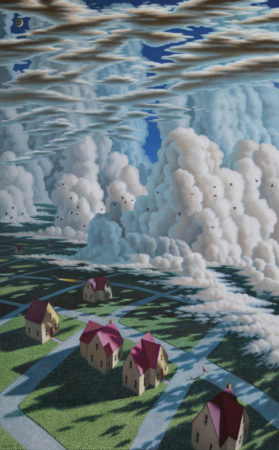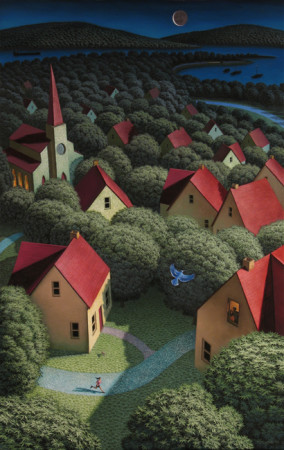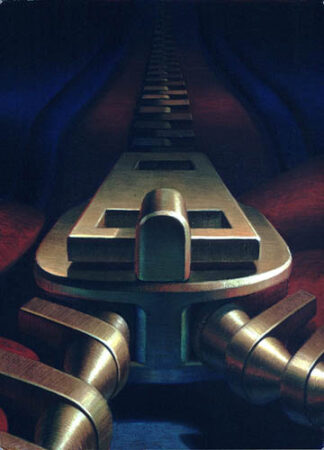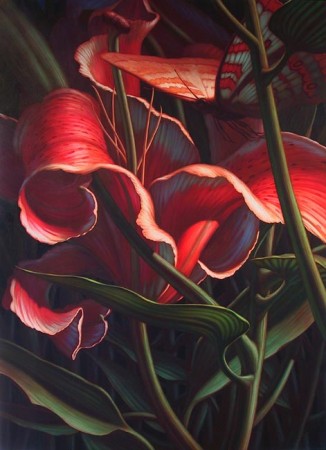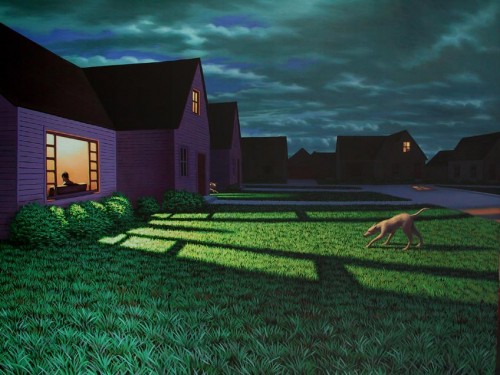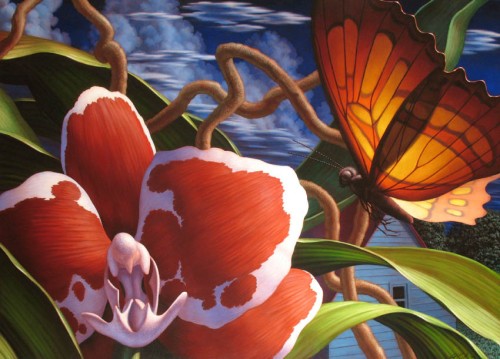This interview has insights into my creative world.
An interview for the Italian website Artmoire (URL no longer active). August 2, 2019
Stormy Weather, oil on canvas, 42″ x 26″, 2021.
Leonard Koscianski was born in 1952 in Cleveland Ohio. He an artist who lives in Annapolis Maryland. He has been an artist since the age of 16. His resume is very short – 1968 to present – Artist.
Leonard comes from a family of two parents and four boys. He is the oldest child. He went to Catholic schools through his first year of college. The son of an attorney and fashion designer he was taught to appreciate precision and craftsmanship from an early age. All of his grandparents came from Poland. In fact, Leonard has his grandfather’s boat ticket from Poland framed and hanging on his wall at home. He was given very little formal art instruction as a child. Drawing, carving, building model airplanes were just part of being a child and growing up. His parents were art and antique collectors, so art was part of his home environment, visiting the local art museum, an annual pilgrimage. Leonard’s parish church had beautiful stain glass windows and religious statues. An altar boy and choirboy, he became well acquainted with the precious objects in his church, as well as the musical masterpieces of Bach and Mendelssohn. During childhood the cartoon artists of “Mad Magazine” were his childhood art stars. It wasn’t until high school that he began to see art as a serious pursuit. When he was 16, he won his high school’s annual art contest, and took a summer painting class at the Cleveland Institute of Art. It was during this time that he began to see himself as an artist. His heroes became Van Gogh, Monet and Picasso.
The Skater”, oil on canvas, 42″ x 26″, 2017.
Leonard Koscianski was a student of R. Buckminster Fuller, and noted American painter Wayne Thiebaud, he received his Bachelor’s degree from the Cleveland Institute of Art, and his Master’s degree from the University of California, Davis. He is an American painter, with a unique visionary style. He has exhibited his psychologically charged artwork worldwide. He is represented by the Meisel Gallery in New York, and the J Willott Gallery in California. His artwork is included in many public and private collections including the Metropolitan Museum of Art in New York, the Philadelphia Museum, and the Chicago Art Institute. It has appeared in the New York Times, the Los Angeles Times, Art News, Art in America, and Art Forum. A popular professor and speaker, he has received numerous awards including the National Endowment for the Art’s Individual Artist Fellowship, and the Rockefeller Foundation’s Bellagio Fellowship. He lives and works in Annapolis, Maryland where he served as a member of the city’s Art in Public Places Commission.
Her Morning Run, oil on canvas, 42″ x 26″, 2015.
Q. What role does the artist have in society?
His role is to make interesting and beautiful objects. Many people love living with beautiful things.
Q. Do you remember the first art you made? What was it and how old were you?
How and when did you first become seriously interested in art?
Tell us about your beginnings, how were your first steps in the art world?
As I child I drew pictures. I still have one that I made when I was 5 years old. All children draw pictures at school. I never thought of myself as special in this regard. I became seriously interested in art when I was in high school. I started off making posters for the high school football and basketball games. Then I won the school’s annual art contest. I started looking at art books. I began painting pictures to impress girlfriends. During these years, art became part of my identity. I was rejected by the first art school I applied to. My high school didn’t have any art classes, I had no portfolio. But I persisted and eventually entered the Cleveland Institute of Art. I got my first show in San Francisco by taking my slide portfolio around to all the galleries until one agreed to represent me. This led to a gallery in Los Angeles (Karl Bornstein), which led to a gallery in New York (Phyllis Kind). It wasn’t easy. I’m not very social, so I don’t network well. It was my artwork that sold me, rather than me selling my artwork.
Zipper, pastel on paper, 41″ x 29″, 1979.
Q. What have you had to sacrifice for this career?
I have had to sacrifice a “normal” prosperous middle-class life. Art income fluctuates a lot. Galleries go out of business, devoted collectors die, some critics love you, some hate you. Being an artist means that there is no “paycheck”. You make objects and then sell them. That’s how you make a living. To do this for a lifetime, an artist must be very dedicated and persistent. One must truly love art to be an artist in modern America. This is a computerized, industrialized culture, so art making can seem like a relic of the past. Very few of my fellow art school students have been able to make a living from their art.
Wild Dogs, oil on canvas, 1982.
Q. Tell us about your particular style and how you came to it?
I am a Postmodern artist. My own style is an eclectic blend of styles that I have appropriated from the past. While in art school, I was a guard in the Cleveland Museum of Art, right across the street from the school. I spent many hours looking at, and copying the great paintings of the past and present. My style is a combination of Surrealism, American Primitive Art, and American Scene Painting. I have also used elements of Mannerism, Romantic Painting, and Dutch art.
Stargazer Lilly and Butterfly, oil on canvas, 64″ x 46″, 2003.
Q. Who are your biggest influences? Are you inspired by the work of your peers or anyone else in particular?
My current work is most influenced by Wayne Thiebaud (one of my teachers), Grant Wood, Edward Hopper, and the Scene Painters of the American Midwest. My animal paintings were influenced by Henri Rousseau, and George Stubbs.
Indian Summer, oil on canvas, 30″ x 40″, 1996.
Q. What does your art aim to say?
The message of my art is that a hidden psychologically charged world lies beneath our own.
Q. Is the artistic life lonely? What do you do to counteract it?
Making art in America can be an isolated activity. This is an occupational hazard. Family, friends, clubs, and church help me to reconnect with society.
Suburbia, oil on canvas, 48″ x 66″, 2001.
Q. Apart from art, what do you love doing?
Artists need to feed their imaginations. I have had lots of hobbies. Astronomy, running, aquariums, art collecting, even bird watching. However, they become research for my paintings. Any outside interest has a way of showing up in my artwork. I used to keep orchids, so there are a number of orchid paintings. Having children is hardly a hobby, but when my children were young, they appeared frequently in my paintings.
Flowers That Fly, oil on canvas, 46″ x 64″, 2008.
Q. What is your philosophy in matters of art?
My art philosophy is an extension of my religious philosophy which is: love God with your whole heart and love your neighbor as yourself. Applied to art it means: Honor inspiration when it comes, and craft the best possible paintings because others will look at them and live with them for many years to come. Some of my paintings have been passed down from one generation to the next.
Q. What does ‘success’ mean to you?
I don’t know. I’m still striving for success. Every time I start a painting, I’m filled with hope. I think that this will be my greatest painting of all. But when it is finished, I’m always a little disappointed, because it has failed to live up to my high hopes. It could always be better. So, I start another painting. With high hopes.
The New Day, oil on canvas, 42″ x 26″, 2019.
Q. What’s the best piece of advice you’ve been given, and by who?
My art school mentor Edwin Mieczkowski once said that your most extreme ideas, the ones that you think people would laugh at, the ones you would self-censor, those are your best ideas.
Ann Truit once told me: “Just keep painting.”
Q. What advice would you give to the next generation?
Keep painting!
Q. What’s something about yourself or your life that might surprise others to learn?
That I am outwardly very conventional. I’m married, have three children, own my own home, and go to church every Sunday. When people first meet me, they think that I must be an engineer, or an insurance executive.

